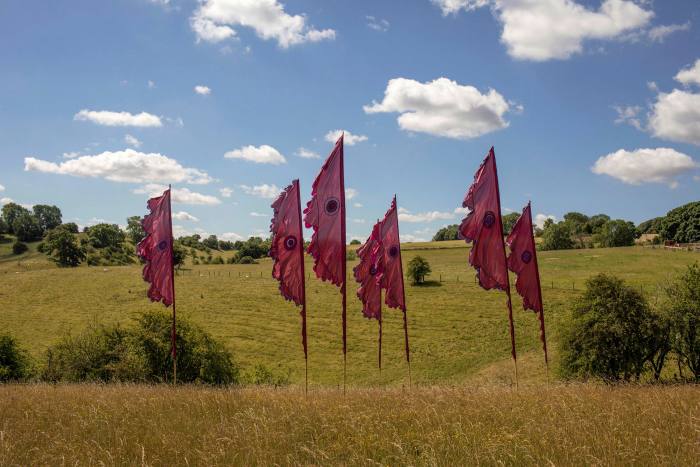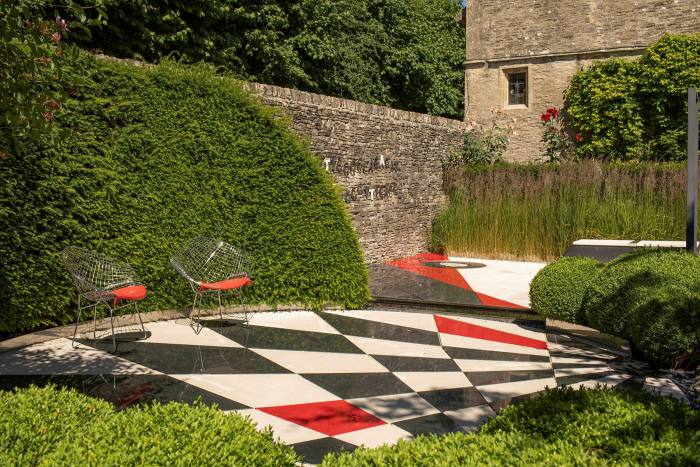At first glance, Througham Court appears to be in perfect harmony with its setting, deep in the rolling hills of the Cotswolds in Gloucestershire. The Grade II*-listed traditional country house dates, in part, from 1610, and later additions include a dry stone terrace designed in the 1930s by Arts & Crafts architect Norman Jewson.
Yet fixed to Jewson’s wall are two rows of letters denoting the mirror DNA sequences from the male Y chromosome. And the floor of the terrace is made not from mellow, honey-coloured Cotswold stone, but a series of stark, asymmetrical shapes in red, black and white. The polygons’ reflective surfaces are interspersed with mirrors and a rill in which the water has been dyed black.
This is the garden that Througham Court’s owner, Christine Facer Hoffman, has developed over the past two decades: a garden based on mathematical formulas, medical science and cosmic theory.
When Facer Hoffman bought the property in 1995, she was a haematologist whose work in fields including epidemiology and immunogenetics earned her international recognition. But a few years later, she decided that “life was too short for doing one thing” and trained to become a landscape architect. Her gardens became a new outlet for her abiding fascination with science.

She says she always had an interest in art as well as science and, from her perspective, landscape design neatly combines the two disciplines. She gained a diploma from the Pickard School of Garden Design and studied computer-aided design (CAD) for landscape designers at Pershore College in Worcestershire. Then she started her own business. Her first commission in 2002 was to design a garden for the inaugural Westonbirt International Garden Festival in Gloucestershire. It seemed a natural step for Facer Hoffman to create a genetics garden, using plants and hard landscaping to represent genes and DNA.
“I chose DNA because I was interested in it at the time,” she says. That first garden established Facer Hoffman’s trait of turning each prevailing scientific preoccupation into a symbolic and metaphorical art form that runs through clients’ gardens.
Her own estate at Througham Court, where she lives with her husband Anthony, covers 55 acres, of which six comprise a cultivated area incorporating Jewson’s original Arts & Crafts garden, and Facer Hoffman’s exploration of theories and ideas in various outdoor “rooms”.
They include The Cosmic Evolution Garden, which she designed after reading a book called Just Six Numbers by Astronomer Royal Martin Rees. The premise of Rees’s book is that the origins and existence of the universe depend on six numbers in physics. Facer Hoffman has inscribed each number on to sandstone spheres representing planets. A seat for visitors represents a black hole.
“When a star dies it [can] form a black hole with such gravitational force that nothing can escape. So this seat is designed to be very comfortable but very difficult to get out of.”

An Eclipse Shadow bed contains what she describes as “cosmic planting”, including black-leaved Ophiopogon planiscapus Nigrescens; Ligularia stenocephala The Rocket; and Cosmos bipinnatus Cosmonaut.
Facer Hoffman says her garden reflects her own personality, but she also wants to make visitors think. She acknowledges that visitors come to see the hard landscaping design, but says that plantings play an important role.
“A garden can’t be a garden unless it has got plants in it. Otherwise it would just be like an art installation in the Tate.”
Plantings act as interludes of normality, such as in the original Arts & Crafts part of the garden, and in a pleached lime walk with seasonal displays of tulips, alliums, agapanthus and nepeta. They also play supporting roles, as with the roses and clematis entwining the Six Pillars of (Scientific) Wisdom that are topped by resin models that document significant moments in the history of biology. Models include giant pills, representing the discovery of penicillin; and a sheep that symbolises Dolly, the first cloned mammal.


In another part of the garden, entering the densely planted Black Bamboo Grove feels like stepping into an eerie fairy tale. A starburst pool is lined with slate as if to mimic the dark sky.
Along Fibonacci’s Walk, a winding path of short grass cut through a field, birch trees are planted at distances according to the Fibonacci sequence, whereby each number is the sum of the preceding two, a pattern found in nature: 1 metre, 2 metres, 3 metres, 5 metres, 8 metres and so on.
The asymmetrical red, black and white polygons that Facer Hoffman has added alongside the Arts & Crafts part of the garden form her Chiral Terrace. In medical science, chirality is a property of asymmetry, used to describe a structure that cannot be superimposed on its mirror image. A chiral quality can have far-reaching consequences, affecting how a drug affects our bodies. For example, the chirality of thalidomide played a significant role in the birth defects caused by the drug in the 1950s-60s. Facer Hoffman designed the terrace to explore the topic of the chirality of molecules after reading a book on the subject.

Occasionally, and to Facer Hoffman’s delight, visitors to the garden play on the themes of her displays. Among the many comments in the visitors’ book is a lengthy tribute, written in a tidy and precise script that is impossible to decipher without a mirror because it is written back to front. The guest was a mirror writer. A few pages later, there is a photograph of identical twins: mirror twins, whose identical traits are asymmetrical, as if either twin is gazing at their reflection in a mirror. Mirror twins are believed to comprise 25 per cent of identical twins worldwide.
When visitors arrive at the garden, which can be accessed on pre-booked guided tours, they enter via the Anatomy of the Black Swan gate. The gate was designed by Facer Hoffman as a visual metaphor of what former trader and risk analyst Nassim Nicholas Taleb calls Black Swans: seemingly improbable, unpredictable events with huge consequences, such as 9/11.

More predictable for Facer Hoffman is her next major project for the estate: a tribute to Charles Jencks, the architectural historian and international designer of both buildings and gardens, including his own 30-acre Garden of Cosmic Speculation in Scotland. Jencks was a friend and collaborator of Facer Hoffman, and when he died in 2019 the pair had been working for several years on a garden design for Througham Court.
“Charles was amazing and his gardens are extraordinary. He was incredibly inspirational in that you would see what he did and think, ‘How could he do that?’ Then I’d have a go at doing it myself,” she says.
The garden they planned is one based on epigenetics: the study of how human behaviour and the environment can affect the way genes work without changing the DNA sequence. An example is the Dutch “hunger winter” of 1944-45, during which starving pregnant women gave birth to children who are thought to have suffered from various conditions throughout their lives due to their genes being affected in the womb by the famine.
With Jencks gone, Facer Hoffman has completed the design and will create the epigenetics garden on her own, in between her work for clients. She says she does not yet know where she will fit it in Througham Court, but is confident that she will find a spot.
“Charles used to say that we were peas in a pod and I don’t now have anyone to talk to about garden design. There aren’t many people doing what we do.”
The epigenetics garden design is, she admits, “complicated”. But as an award-winning, former consultant haematologist and past president of the British Society for Parasitology, Facer Hoffman is undaunted by complex ideas. The new garden will add another chapter to Througham Court’s metaphorical exploration of science — another story to be told, as Facer Hoffman puts it.
“I aim to create curiosity and my garden is a book with each area telling a story. A garden should be a voyage for the mind as well as the feet.”
Find out about our latest stories first — follow @FTProperty on Twitter or @ft_houseandhome on Instagram
Stay connected with us on social media platform for instant update click here to join our Twitter, & Facebook
We are now on Telegram. Click here to join our channel (@TechiUpdate) and stay updated with the latest Technology headlines.
For all the latest Business News Click Here
For the latest news and updates, follow us on Google News.
